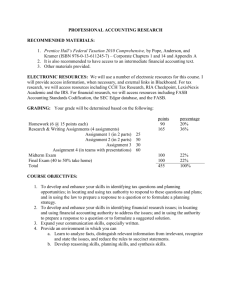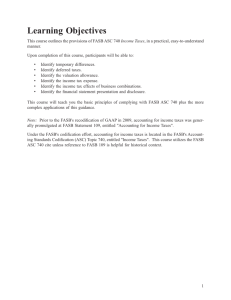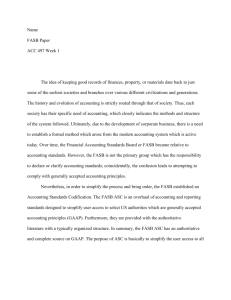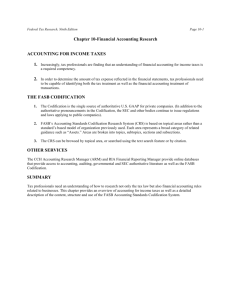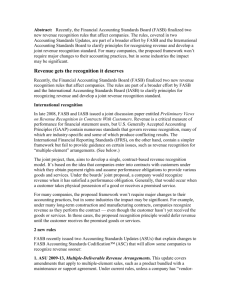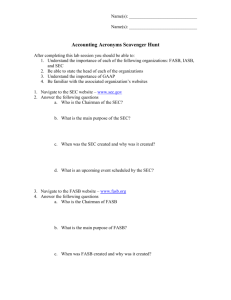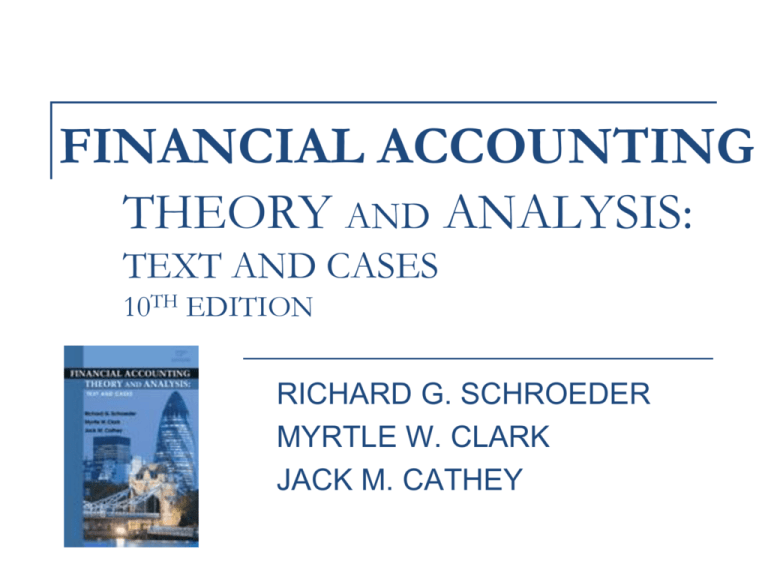
FINANCIAL ACCOUNTING
THEORY AND ANALYSIS:
TEXT AND CASES
10TH EDITION
RICHARD G. SCHROEDER
MYRTLE W. CLARK
JACK M. CATHEY
CHAPTER 1
THE DEVELOPMENT OF
ACCOUNTING THEORY
Introduction
What is theory?
Webster defines theory as:
“Systematically organized knowledge, applicable in a relatively wide
variety of circumstances, a system of assumptions, accepted principles
and rules of procedure to analyze, predict or otherwise explain the
nature of behavior of a specified set of phenomena.”
Normative theory
Positive theory
Why is the development of a general theory of
accounting important?
What is the relationship of accounting research
to accounting theory?
THE EARLY HISTORY OF
ACCOUNTING
Zenon Papyri
Renaissance
Fra Luca Pacioli
The evolution of joint ventures into ongoing
businesses
The impact of the industrial revolution and
the progressive movement
The concept of capital maintenance
The accountant as a protector of business
interests
ACCOUNTING IN THE UNITED
STATES SINCE 1930
Meetings between NYSE and AIA
AAA
SEC
Securities Act of 1933
Securities Exchange Act of 1934
Committee on Accounting Procedure
Accounting Principles Board
Financial Accounting Standards Board
THE ACCOUNTING PRINCIPLES
BOARD
Formation and structure
Types of pronouncements
Accounting for the investment tax credit (1961)
APB Opinions
APB Opinions 2 & 4
Rule 203
Criticism of the APB
Independence of members
Structure
Response time
THE FINANCIAL ACCOUNTING
STANDARDS BOARD
The Wheat Committee
The Trueblood Committee
The FASB was established
Structure of the FASB
Appoint and
fund
------|
|
|
Financial
Accounting
Foundation
Govern
Board of
Trustees
Appoint
Appoint and
fund
Financial
Accounting
Standards
Advisory
Committee
(approx.
20 members)
Admin.
Staff
Financial
Accounting
Standards
Board
(5 members)
Appoint
Research Staff
Task Forces
of the
Standards
Board
Electors
FASB
Sarbanes-Oxley Section 108
Mission
Types of pronouncements
Statements of Financial Accounting Concepts
Statements of Financial Accounting Standards
Interpretations
Technical Bulletins
FASB Accounting Standards Codification
July 1, 2009
Single source of GAAP
Effective for interim & annual periods ending
after September 15, 2009
FASB Accounting Standards Codification
Goals:
Simplicity
Accurate representation of GAAP
Up-to-date research
Expectation
Reduce research time
Mitigate noncompliance risk
Real-time updates
Assist FASB
FASB Accounting Standards Codification
July 1, 2009
No more SFAS
Changes publicized through an ASU
Summarize key provisions
Detailed amendments to FASB Codification
Explain basis for decision
FASB
Emerging Issues
Standards Overload
Standard setting as a political process
Economic Consequences
GAAP
Evolution of phrase:
Changed wording of auditor’s certificate brought about by
meetings between NYSE and AIA
The APB’s definition
The Auditing Standards Executive Committee’s definition
SAS 69: determining acceptance of a specific principle
is difficult
No single reference
SFAS No. 162
2008
Hierarchy of GAAP
GAAP Hierarchy
LEVEL A:
FASB Statements
FASB Interpretations
SEC Rules and Interpretive Releases
Accounting Principles Board Opinions (unless amended)
Account Research Bulletins (unless amended)
LEVEL B:
FASB Technical Bulletins
AICPA Industry Audit Guides that have been reviewed by the FASB
GAAP Hierarchy
LEVEL C:
AcSEC Practice Bulletins that have been reviewed by the FASB
Consensuses reached by the EITF
LEVEL D:
AICPA Accounting Interpretations (no longer issued)
FASB Implementation Guides
Other widely recognized or prevalent accounting practices
SFAS No. 168
2009
Codification
Hierarchy
Replaces 162
Rule 203
Ethics
Must consider pronouncements as
primary source of GAAP
THE ROLE OF ETHICS IN
ACCOUNTING
The public accountant as a
watchdog
Accounting in Crisis – The Events of
the Early 2000s
Enron and the Accounting Scandals
Accounting in Crisis – The Events of
the Early 2000s
1.
Two major changes in the accounting profession have
taken place in the wake of the accounting scandals:
Arthur Andersen
formerly one the Big 5 audit firms
has gone out of business
Sarbanes-Oxley Act
2.
President Bush signed into law July 2002
imposes a number of corporate governance rules on publicly traded
companies
International Accounting Standards
The concept of harmonization
The IASB
The IASB’s objectives:
1.
2.
To formulate and publish in the public interest accounting
standards to be observed in the presentation of financial
statements and to promote their worldwide acceptance and
observance
To work generally for the improvement and harmonization
of regulations, accounting standards, and procedures
relating to the presentation of financial statements.
41 Statements of Accounting Standards and 10
Statements of Financial Reporting Standards to date
No enforcement authority
End of Chapter 1
Prepared by Kathryn Yarbrough, MBA
Copyright © 2011 John Wiley & Sons, Inc. All rights reserved.
Reproduction or translation of this work beyond that permitted in
Section 117 of the 1976 United States Copyright Act without the
express written consent of the copyright owner is unlawful. Request
for further information should be addressed to the Permissions
Department, John Wiley & Sons, Inc. The purchaser may make backup copies for his/her own use only and not for distribution or
resale. The Publisher assumes no responsibility for errors,
omissions, or damages, caused by the use of these programs or from
the use of the information contained herein.


